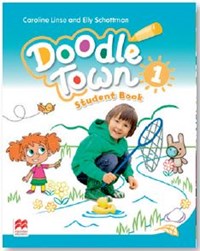Doodle Town, Macmillan Education 2016/17
Caroline Linse, Elly Schottman and Anne Stribling
Macmillan Education 2016/7

Doodle Town is a four-level set of course materials for pre-school and early primary aged children. The adults involved in teaching these young children English will be kindergarten teachers or home-educating parents.
As the title suggests, artwork and drawing play a central role in the approach, the rationale, according to the website, being that they ‘improve memory, experience, imagination, and observation’. The content is based on the US English Language Arts and Math Common Core State Standards, adapted for EFL. The description of the content and approach seems similar to the UK Early Years Framework in the concern for physical, emotional and social development alongside age-appropriate cognitive development and first steps in subject-specific Literacy and Maths material. While it is good to see links with whole child development and general educational values made by English Language courses, it should perhaps be acknowledged that unless English lessons based on these principles take up a substantial part of the child’s week, the contribution made to general development may be less than is aspired to.
Doodle Town is a character-based course with a brother and sister, Gus and Meg, their friend Kit, and the usual cute mascot, Doodle Bunny. These characters model the experiences of the children following the course. The variety of English on audio is American and the intended main context of use, as evidenced by the Letters to Parents, seems to be English as an Additional Language (EAL) classes in a USA kindergarten or at an early primary stage. This may explain some of the strongly cross-curricular features of the materials, which come over as business-like and thorough in content terms and generally pushing for literacy and numeracy development in ways that would be less palatable in many out-of-school contexts. There are, however, imaginative and fun elements, with a story for each Unit and numerous songs, many of them traditional or adaptations of traditional children’s songs. These come in two versions, one with the words sung over a backing and the other a karaoke version with musical backing only.
As well as the physical materials, there is an online component for learners and educators, with access to copious audio and visual material, including printable picture-, number- and letter-cards and templates for letters to parents in English, Spanish, Korean, traditional and simplified Chinese as well as Arabic. A projectable version of the Activity Book is available online.
The core and guiding element of the course seems to be the Activity Book, which is intended for learners to draw in, colour in, write in and occasionally cut up. Lessons are organised into topic-based units, with a well-tried array of areas such as My Toys, My Family, About Me, along with other topics such as I Can … and I Like … . Eight lessons per unit are envisaged with the core activities supplemented by Maths and Literacy work in the Skills Pads. The Skills Pads, like the pages of the Activity Book, have the useful feature of providing the teacher with the target oral language to be used. This is given in tiny print at the bottom, thus providing a ‘script’ for the classroom language for each lesson.
The Teacher’s Guides for each level are explicit and full of ideas but the way in which the resource books are organised also makes the intentions fairly clear. This abundance of material, both print and electronic, is great in one way but it provides a lot for a teacher, and a small child, to juggle. Perhaps because so much is centred around worksheets, it would be possible for teachers to work their way through the materials in a fairly unadventurous way, reflecting the fact that, worldwide, many teachers of English to the very young seem not yet to be well-equipped for their roles and publishers naturally wish to support them. This type of teacher will prefer the safe ground provided by the worksheets and tracing, drawing and writing activities that the children will be mostly engaged with.
There are other questions to be asked, for example whether it is appropriate to be pushing the first steps towards literacy and handwriting in English from the very first lessons even though at Level One this is limited to tracing over the letters and numbers. Creating a seamless smooth-flowing lesson, including a lot of oral interaction around the multiple worksheets, could be a challenge. A skilled Early Years teacher might manage it and also be able to weave in the songs, stories and other imaginative material that children crave but the inexperienced teacher might be tempted to use the worksheets as a safety-blanket or for non-linguistic ‘busy work’.
Shelagh Rixon worked at Warwick University, coordinating the MA in Teaching English to Young Learners until her retirement in 2010. She is now a freelance writer and researcher.
Comments
Write a Comment
Comment Submitted